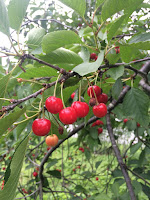The Intensity of June
 I think it was May yesterday, and now it is almost
the middle of June. If I don’t finish this today, it will be the end of June
when I return! Summer is like that: if you blink, it disappears! June is the
beginning of the intense season, where every hour and every day is packed with
harvest, planting, and planning.
I think it was May yesterday, and now it is almost
the middle of June. If I don’t finish this today, it will be the end of June
when I return! Summer is like that: if you blink, it disappears! June is the
beginning of the intense season, where every hour and every day is packed with
harvest, planting, and planning.  Still picking strawberries, starting to pick
tomatoes, raspberries and cherries, checking on the plums, peaches,
blueberries, and blackberries; starting to pick cucumbers, beans, and squash—it
definitely feels like the summer wave is here, even though it is only 71
degrees today. In about 3 weeks, nearly everything will be ready for continual
harvesting.
Still picking strawberries, starting to pick
tomatoes, raspberries and cherries, checking on the plums, peaches,
blueberries, and blackberries; starting to pick cucumbers, beans, and squash—it
definitely feels like the summer wave is here, even though it is only 71
degrees today. In about 3 weeks, nearly everything will be ready for continual
harvesting.
Although there is a press to get everything planted,
we are busy with harvests and with taking out as well as putting in plants. As
soon as one crop is finished—lettuce, for example—another one goes in (say,
cucumbers!). This “succession planting” helps us get in at least 3-4 crops over
the year for most parts of the farm. Some areas even more! To do this takes
strategic planning and preparation.
 Seeds are started in the propagation greenhouse,
where the seedlings are treated like the newborns they are: heated germination
mats, careful watering, shade cloths or row covers as needed (depending on the
weather!), and up-potting to larger containers as the plants grow roots and
leaves. Then, if we have planned correctly, the plants are the right size to be
planted either outside or in an unheated hoop house just as the prior crop in
that space has finished. Sometimes both inside and outside: the inside crop
will mature slightly ahead of the outside crop and give us a jump on the season
for that crop. And so on, throughout the season. In addition to planning the
planting time, we rotate the type of crops in each section of ground to achieve
nutrient balance and pest management. Lettuce-cucumbers-beans-arugula might be
one area’s rotation, for xample.
Seeds are started in the propagation greenhouse,
where the seedlings are treated like the newborns they are: heated germination
mats, careful watering, shade cloths or row covers as needed (depending on the
weather!), and up-potting to larger containers as the plants grow roots and
leaves. Then, if we have planned correctly, the plants are the right size to be
planted either outside or in an unheated hoop house just as the prior crop in
that space has finished. Sometimes both inside and outside: the inside crop
will mature slightly ahead of the outside crop and give us a jump on the season
for that crop. And so on, throughout the season. In addition to planning the
planting time, we rotate the type of crops in each section of ground to achieve
nutrient balance and pest management. Lettuce-cucumbers-beans-arugula might be
one area’s rotation, for xample.
And if this wasn’t planned out in March, it isn’t
happening in June.
 As we harvest, we evaluate what can we do to have
more or less of a crop? How can we have strawberries not affected by the rain?
(That is a real discussion; we will know next year if we have fooled Mother
Nature.) Was the fava bean tunnel a success and worth that space? We love our
cherry tree that ripens 10 days before any other cherry tree we have
encountered (it is one our grandfather, John Webster, planted). Perhaps it is
time to take cuttings and graft them onto root stock to have more of these
fabulous early cherries. It will be five years before those bear fruit, but
that will be awesome!
As we harvest, we evaluate what can we do to have
more or less of a crop? How can we have strawberries not affected by the rain?
(That is a real discussion; we will know next year if we have fooled Mother
Nature.) Was the fava bean tunnel a success and worth that space? We love our
cherry tree that ripens 10 days before any other cherry tree we have
encountered (it is one our grandfather, John Webster, planted). Perhaps it is
time to take cuttings and graft them onto root stock to have more of these
fabulous early cherries. It will be five years before those bear fruit, but
that will be awesome!
And at the end of each day, we are grateful for our
heritage, our farm, our community, our staff and customers, and our family. See
you soon!
~ Ruth




Comments
Post a Comment